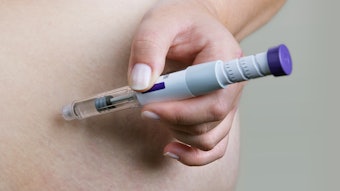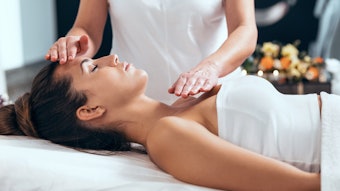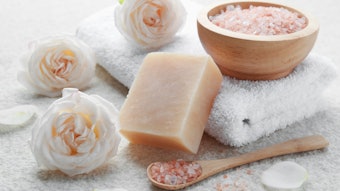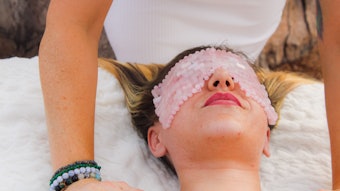
Beauty in 2024 has evolved with a focus on skin health and radiance achieved by simplified, sophisticated, efficacious skin care routines. Mintel recently identified1 the related trend of “NeuroGlow” – an expression of a deeper connection between the mind and body – which is key in elevating the role of beauty in overall well-being.
As consumer understanding of this connection deepens, younger generations of women in particular will seek a comprehensive approach to beauty that entails improving external appearance and enhancing mental and emotional well-being. Attaining a glowing look and feel in skin – and thereby, mind-body beauty and wellness – hinges upon skin’s homogeneity, the cornerstone of skin health and attractiveness.2 As such, it is essential to bring skin care back to its foundation: skin cleansing, which remains the first step of any good skin care routine.
Cleansing has a profound impact on facial skin health, not only by removing impurities, but as a form of self-care. The sensation of water on skin can wash away stress accumulated throughout the day. It is therefore not just about physical cleanliness but also about mental and emotional refreshment, helping to relieve tension and signal to the body it is time to unwind and prepare for relaxation or rest.3, 4
Cleansing also addresses the effects of hormonal changes during the menstrual cycle. Excessive sebum production, for example, can cause premenstrual acne flare-ups in part by providing an environment conducive to microbial growth and by affecting interactions between the microbiome and skin – and acne and its sequelae are well-known to impact skin homogeneity, health and, in turn, self-esteem and well-being.5
Facial skin cleansing, especially in terms of acne control, requires considering the intricate dynamics of hormonal influences, microscopic nuances in skin biology, and delicate balance of the skin microbiome. Select examples of these dynamics from the literature are presented here to explore how cleansing could positively affect them to improve skin homogeneity, health and radiance for mind-body beauty.
Gentle Cleansing: Finding Balance
As is well-known, skin cleansers are designed to remove excess sebum, exogenous pollutants and products applied during the day such as makeup. Surfactant technologies in cleansers dissolve hydrophobic substances into their aqueous phase, to be washed away. Importantly, the choice of cleanser can impact the delicate skin barrier, therefore effective cleansing must be balanced to maintain barrier protection.
Cleansers often contain more than one surfactant but a recent analysis of ten different cleansers containing 30 surfactants showed that presence of surfactants did not necessarily correlate positively with cleansing and acne reduction. Indeed, the authors concluded, “The bottom line is that a good facial cleansing product [does not] have to contain a lot of chemicals and surfactants.”
This underscores the need for a balanced approach to skin care formulation, as well as understanding consumers’ skin types and skin care routines.6 This is particularly true prior to menstruation when acne flares occur, as skin barrier integrity is directly involved with changes related to comedone (blackhead) formation and inflammation, and it should not be compromised.7
A systematic review of clinical studies of washing and cleansing efficacy in acne was carried out a few years ago to guide the treatment recommendations of dermatologists. However, it concluded that given the low number of well-performed clinical studies of cleansers and washing, it is in fact difficult to formulate reliable recommendations.8
Premenstrual Acne Flare-ups
Acne is an inflammatory disease of the pilosebaceous follicle affecting a substantial percentage (even 1 in 2) of adult women.9 Female chin acne flare-ups prior to menstruation are a particular form occurring along the mandible although woman may experience various spots and blemishes during the luteal phase of the menstrual cycle.
A few years ago, French research shed light on this problematic skin condition. In a single-center study, 32 young adult women experiencing premenstrual acne flares displayed a significant increase in the number of papules and, to a lesser extent, closed comedones on their faces. A well-known brand sponsored the study whereby twice daily, without any acne treatment, participants applied a standardized facial care regimen targeting skin inflammation that included a foaming cleansing gel and a moisturizer as the placebo (and the basis for the formulation of the dermocosmetic).
Results showed the treatment in part alleviated premenstrual inflammatory flare up. They also highlighted the significance of working with the female cycle and tailoring skin care approaches to address hormonal fluctuations that may impact facial skin health.10 Indeed, historically, research has shown that a deep cleansing routine involving comedone extractions earlier in women’s cycles could potentially prevent progression to inflammatory papules.11
The link of daily facial cleansing to a reduction in comedones has not been explored. However, an older study has shown improvements in open comedones and noninflammatory lesions with cleansing twice daily.12 Targeting comedone development is essential in premenstrual acne, as comedones hinder healthy skin appearance. Notably, the repartition of comedones on the face also is not homogeneous; a great number can appear in the mandibular area preceding acne lesions.13
The newest topical therapies to minimize facial pilosebaceous openings are natural plant-derived copper chlorophyllin complex sodium salt and tetra-hydro-jasmonic acid (LR2412). Clinical trials of these botanicals are limited with small sample sizes but may provide new alternatives to vitamin A derivatives and peels.14
Microscopic Insights into Acne
Understanding microscopic details of skin biology can also pave the way for targeted skin care interventions. For example, one study examining infundibulum morphology using reflectance confocal microscopy revealed notable differences in apparently healthy skin on the forehead and chin areas affected by acne.
More specifically, follicles in healthy skin showed a larger-diameter, thicker and hyper-keratinized follicular border, with more keratin plugs compared to controls.13 In the mandibular area, some follicles presented isolated inflammation without hyper-keratinization, and others had both thickened borders with an onion-like appearance and keratin plugs associated with inflammation.
These variations are important considerations for formulators developing cleansers and other acne treatment products, as a balanced approach must be taken.15
Acne and the Skin Microbiome
It is well-known that the skin commensal Cutibacterium acnes plays a pivotal role in disease development. Early sebum production in childhood is followed by colonization with C. acnes and correlated with the development of acne in children.16 However, in adulthood, when the skin population with C. acnes is completed, acne flare-ups depend on intrinsic factors that reflect the development of the C. acnes population in the pores.
A shift within the C. acnes population has been observed in acneic skin, where specific phylotypes of C. acnes induce inflammation and dominate over non-inflammatory C. acnes strains.17 Until now, it has been unclear why this shift happens but several new microbiome related technologies attempting to tackle this issue have been developed. The most promising so far is a non-inflammatory probiotic C. acnes strain intended to replace pathogenic strains.18
Adding such probiotic technologies to cleansers may be a viable strategy to formulating acne care. Another decade-old approach, rather than attempting to directly decrease the C. acnes strains that contribute to inflammation, is to modify the environmental factors conducive to C. acnes growth.
For example, researchers previously described reducing the water activity in the follicle with a biocompatible solute of very high water solubility.19 Per the authors, the solute required had to be small, easily diffusible and minimally soluble in sebaceous lipids. Xylose and sucrose were identified to fulfil these criteria with the added benefit of being nonfermentable by P. acnes.
Gentle comedone extraction, i.e., applying mild pressure to extract the contents of the follicles, has also proven beneficial. Keratinocyte hyperproliferation and excessive sebum within the follicle cause its widening, likely inducing hypoxia and encouraging bacterial growth in this anaerobic environment. Removing these blockages thereby alters this favorable environment.
However, manipulating the unique habitat of C. acnes in the follicle in this manner presents a challenge that is not a part of daily cleansing routines. There thus remains a need for more intense, deeper modes of cleansing especially for the chin areas prior to menstruation to allow for follicle opening and oxygenation to reduce the anaerobic environment in acne lesions.20
Conclusion
Facial skin cleansing touches the intricate dynamics of hormonal influences, microscopic nuances of facial skin biology and the delicate balance of the skin microbiome. The journey to optimal skin health begins with understanding the impact of this skin care step.
An approach to cleansing that considers individual skin needs and embraces new scientific findings and innovative formulations is key to unlocking radiant and healthy facial skin. Examples described here, i.e., manipulating the microbial growth environment and timing treatments with the right phase of the menstrual cycle for the highest impact, present untapped opportunities.
References
1. Mintel. (2023, Oct 2). Mintel announces global beauty and personal care trends for 2024. Available at https://www.mintel.com/press-centre/mintel-announces-global-beauty-and-personal-care-trends-for-2024/
2. Sun, A.-H., Zhang, X., Lu, N., Li, J. and Wang, Z. (2022, Nov 1). Your face looks the same as before, only prettier: The facial skin homogeneity effects on face change detection and facial attractiveness perception. Front Psychol. Available at https://www.frontiersin.org/journals/psychology/articles/10.3389/fpsyg.2022.935347/full
3. Lee, S.W.S., Millet, K. and van der Wal, A. (2022, Jul 9). Actual cleaning and simulated cleaning attenuate psychological and physiological effects of stressful events. Social Psychological and Personality Sci. Available at https://journals.sagepub.com/doi/abs/10.1177/19485506221099428
4. Aliouche, H. (Accessed 2024, Feb 20). Investigating the link between cleaning and mental health. News Medical Life Science. Available at https://www.news-medical.net/health/Investigating-the-Link-between-Cleaning-and-Mental-Health.aspx
5. Steventon, K. (2020, Oct 1). All judgements aside: Acne perception and care. Cosm & Toil. Available at https://www.cosmeticsandtoiletries.com/21835861
6. Güder, S., Sr and Güder, H. (2023). Investigation of the chemical content and user comments on facial cleansing products. Cureus. Available at https://www.cureus.com/articles/154314#!/authors; doi:10.7759/cureus.38673
7. Schachner, L.A., Alexis, A.F., … Woolery-Lloyd, H., et al. (2023, Nov 2). Insights into acne and the skin barrier: Optimizing treatment regimens with ceramide-containing skincare. J Cosmet Dermatol. Available at https://pubmed.ncbi.nlm.nih.gov/37605504/
8. Stringer, T., Nagler, A., Orlow, S.J. and Oza, V.S. (2018, Feb 25). Clinical evidence for washing and cleansers in Acne vulgaris: A systematic review. J Dermatolog Treat. Available at https://pubmed.ncbi.nlm.nih.gov/29460655/
9. Fabi, S.G., Beleznay, K., Berson, D.S., Cohen, J.L., Lee, S. and Dayan, S.H. (2023, Jul 4). Treatment of acne in the aesthetic patient: A round table update. J Cosmet Dermatol. Available at https://pubmed.ncbi.nlm.nih.gov/37403516/
10. Saint-Jean, M., Khammari, A., Seite, S., Moyal, D. and Dreno, B. (2017). Characteristics of premenstrual acne flare-up and benefits of a dermocosmetic treatment: A double-blind randomized trial. Eur J Dermatol. doi:10.1684/ejd.2016.2952
11. Steventon, K. (2011). Expert opinion and review article: The timing of comedone extraction in the treatment of premenstrual acne--a proposed therapeutic approach. Int J Cosmet Sci. doi:10.1111/j.1468-2494.2010.00610.x
12. Choi, J.M., Lew, V.K. and Kimball, A.B. (2006, Sep-Oct). A single-blinded, randomized, controlled clinical trial evaluating the effect of face washing on Acne vulgaris. Pediatr Dermatol. Available at https://pubmed.ncbi.nlm.nih.gov/17014635/
13. Muguet, L., Vourc'h, M., Saint-Jean, M., et al. (2018). Confocalmicroscopy in adult women with acne. Int J Dermatol. doi:10.1111/ijd.13910
14. Dong, J., Lanoue, J. and Goldenberg, G. (2016, Jul). Enlarged facial pores: An update on treatments. Cutis. Available at https://pubmed.ncbi.nlm.nih.gov/27529707/
15. Lam-Phaure, L. (2022, Apr 28). Formulating on trend: Healing acne care. Cosm & Toil. Available at https://www.cosmeticsandtoiletries.com/formulas-products/formulating-basics/article/22197640
16. Mourelatos, K., Eady, E., Cunliffe, W., Clark, S. and Cove, J. (2007). Temporal changes in sebum excretion and propionibacterial colonization in preadolescent children with and without acne. Br J Dermatol. doi:10.1111/j.1365-2133.2006.07517.x
17. Hajam, I., Katiki, M., McNally, R., et al. (2023). Functional divergence of a bacterial enzyme promotes healthy or acneic skin. Nat Commun. Available at https://doi.org/10.1038/s41467-023-43833-8
18. Paetzold, B., Willis, J., Pereira, J., et al. (2019). Skin microbiome modulation induced by probiotic solutions. Microbiome. doi:10.1186/s40168-019-0709-3
19. Eady, E., Layton, A. and Cove, J. (2013). A honey trap for the treatment of acne: Manipulating the follicular microenvironment to control Propionibacterium acnes. Biomed Res Int. doi:10.1155/2013/679680
20. Sitohang, I.B.S., Soebayro, R.W. and Kanoko, M. (2021, Jun 1). Acne lesion extraction versus oral doxycycline for moderate Acne vulgaris: A randomized clinical trial. J Clin Aesthet Dermatol. Available at https://www.ncbi.nlm.nih.gov/pmc/articles/PMC8594536/










